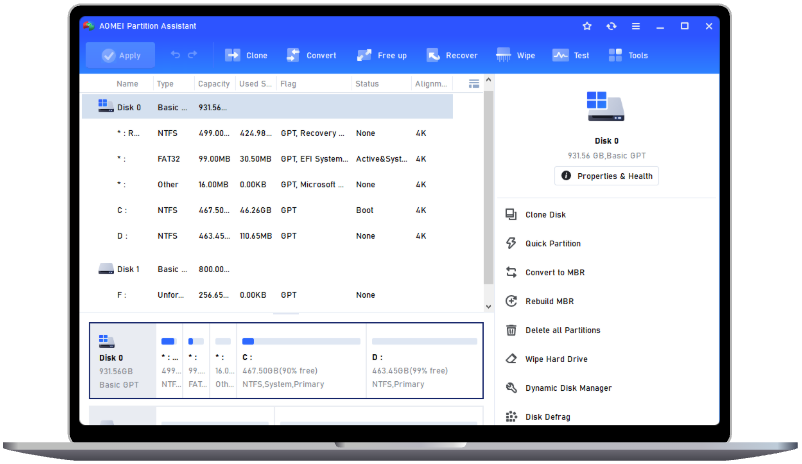How to Fix Missing Unallocated Space After the Volume Shrink?
You can resize partition size to fix missing unallocated space after the volume shrink. This tutorial will give you detailed information about how to effectively fix it.
Why does missing unallocated space occur after the volume shrink?
Windows’ built-in Disk Management tool allows you to shrink a partition to create unallocated space for new partitions or extending others. Generally, you enter the utility and click Shrink Volume, then enter the amount of space to shrink, and then the freed space will appear as “Unallocated” (black bar) in Disk Management. But sometimes, the space will disappear without any reason.
Here’s a table explaining why unallocated space may go missing after shrinking a volume and how to fix it:
| Cause | Explanation | Solution |
|---|---|---|
| File system errors or missing system files | If the file system has errors or crucial system files are missing, the system might not correctly recognize or allocate the unallocated space. | Run sfc /scannow in Command Prompt to scan and repair corrupted system files. |
| Drive corruption | Corruption in the drive’s partition table or bad sectors can cause the unallocated space to become inaccessible. | Use CHKDSK /f /r in Command Prompt to scan and repair disk errors. |
| Malware or viruses | Malicious software can modify partition structures, making unallocated space disappear or become unusable. | Perform a full system scan with antivirus software and remove threats. |
| Outdated hard drive drivers | If the disk drivers are outdated or incompatible, the OS may not detect or allocate unallocated space properly. | Update disk drivers via Device Manager or install the latest drivers from the manufacturer’s website. |
| Windows Disk Management limitations | Windows’ built-in Disk Management sometimes fails to extend/shrink partitions properly, leaving unallocated space inaccessible. | Use third-party tools like AOMEI Partition Assistant’s "1-Click Adjust Space" to manage partitions effectively. |
If you encounter this issue, here are some practical methods will help you fix missing unallocated space after the volume shrink.
How to fix missing unallocated disk space after shrinking the volume?
Several solutions exist, such as scanning for system file errors, using CHKDSK commands, or third-party tools as an alternative. Among these, AOMEI Partition Assistant stands out for its simple "1-Click Adjust Space" feature to quickly reclaim missing space. You can follow the 4 fixes to solve the missing unallocated space after the volume shrink issue.
Fix 1. Use an alternative to Shrink Volume
AOMEI Partition Assistant “1-Click Adjust Space” is the best alternative to Windows Disk Management for shrinking volumes. It works seamlessly on NTFS and FAT32 volumes across all Windows versions, including Windows 11, 10, 8, and 7, for both 32-bit and 64-bit systems. Businesses can also use its Server Edition for Windows Server.
The 1-Click Adjust Space can automate partition resizing with few clicks, preventing unallocated space from becoming unusable—a common issue with Windows Disk Management, which requires manual adjustments and often fails due to system file restrictions, this feature automates partition resizing, preventing unallocated space from becoming missing and inaccessible.
This tool also supports shrinking partitions with unmovable files, ensuring smooth adjustments without limitations. Additionally, it repairs disk errors, supports various file systems, and allows resizing or formatting multiple partitions, including recovery partitions. With its user-friendly interface and advanced recovery tools, AOMEI Partition Assistant provides a safer, more efficient alternative to Disk Management for partition management.
The Best Windows Disk Partition Manager and PC Optimizer
Step 1. Install and launch AOMEI Partition Assistant. Right-click a partition (here is D: partition) you want to adjust space and select "1-Click Adjust Space".
Step 2. If you want to use the space on F: to expand D:, you can simply drag the dot near the partition F: head backward to shrink the partition F: and enlarge the partition D: at the same time. Then click "OK".
Tips: You can simultaneously drag the dot near the partition C: tail forward to shrink the partition C: so the D: will also be enlarged with the space of C: at the same time. In this case, you can adjust all partition space (C:, D:, and F:) on the disk.
Step 3. You can preview the operation by viewing the "Pending Operations". To commit the "Pending Operations", please click "Apply" and "Proceed".
Step 4. The process will start and you can check the progress. It might take time to finish the operation.
Step 5. Wait for the operation to be finished. After it is completed successfully, you will find D: is enlarged and both D: and F: are adjusted.
Fix 2. Run System File Checker (SFC)
CHKDSK (Check Disk) scans your drive for errors, bad sectors, or file system issues that might hide unallocated space. This is ideal if the missing unallocated space is caused by disk corruption.
Step 1. To use command prompt check disk, you need to open the Command Prompt as administrator. Next, follow the example of how to use the disk check cmd on Windows 10:
Step 2. Press Windows + R simultaneously, type cmd, and press Enter. Then, you will get into a command prompt and you can start to check disk with the command line. If you do not know how to use it, you can type chkdsk /? and hit Enter, which will give you its parameters or switches.
If you cannot boot your computer, you can run cmd for check disk either by booting the operating system into the recovery mode or by using the original installation disc to run the command prompt.
For example, if you want to test the integrity of the G: drive, you can type the command in the prompt: "chkdsk g:", To find and repair any errors that are found in G: drive, type "chkdsk g: /f" instead.
About the different CHKDSK parameters, here simply explain what does CHKDSK /f /r /x means:
- What does CHKDSK /f /r /x mean?
- /f: Fixes disk errors. Without this, CHKDSK only reports errors without fixing them. (The /f command will lock the selected drive for checking. If it can't lock it, you'll be asked to schedule a check for the next restart. On Windows 10, scanning for errors will prompt you to do this at the next system boot.)
- /r: Finds bad sectors and recovers readable data. This is a detailed check that may take more time, especially on big or busy drives.
- /x: Dismounts the disk before scanning to ensure CHKDSK has exclusive access for repairs, closing any open files to prevent data corruption.
🌟Notice: Check Disk can't repair volumes that are in use. If the volume is in use, it will display a prompt that asks if you want to schedule the volume to be checked the next time you restart the system. Click Yes.
Fix 3. Update the hard drive drivers
Outdated drivers can prevent your system from detecting unallocated space. Updating ensures your drive communicates properly with Windows.
Step 1. Press Windows + X, then select “Device Manager”. Expand “Disk drives”, right-click your drive, and select “Update driver”.
Step 2. Choose “Search automatically for drivers” and follow the prompts. Restart your PC to apply changes.
Fix 4. Scan for virus and malware
Malware can corrupt partitions or hide disk space, causing hard drive space missing after partition shrink as well as the unallocated space. A full system scan removes threats and restores normal disk behavior.
Step 1. Press Windows + Q, type “Windows Security”, and open it.
Step 2. Go to “Virus & threat protection” > “Quick Scan”.
If threats are found, click “Remove” and restart your PC.
Conclusion
Missing unallocated space after the volume shrink is a common issue in Windows Disk Management due to file system errors, drive corruption, malware, outdated drivers, or system limitations. While built-in tools like CHKDSK and SFC can help fix some issues, AOMEI Partition Assistant “1-Click Adjust Space” offers a more reliable and user-friendly solution. It automates partition resizing, prevents unallocated space from becoming inaccessible, supports multiple file systems, and repairs disk errors. With its intuitive interface and advanced recovery features, AOMEI provides a safer and more efficient alternative to Disk Management for managing partitions and recovering lost space.


